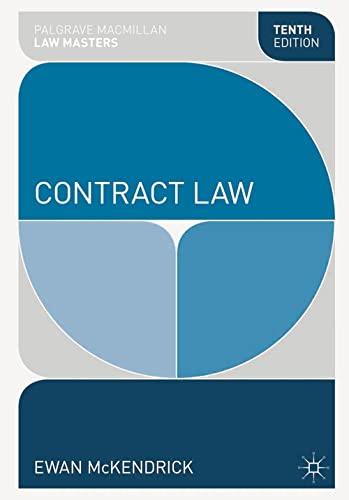Question
Assume you have a client, Jack Brilliant, who has been charged with violating the National Motor Vehicle Theft Act. Last weekend a friend of his,
Assume you have a client, Jack Brilliant, who has been charged with violating the National Motor Vehicle Theft Act. Last weekend a friend of his, Sam Slick, told your client he had just acquired a new motor boat, but that he did not know how to run it. He asked your client if he would go out for a ride with him on the Connecticut River and show him how to drive the boat. Your client agreed. They left from a marina in Massachusetts and headed south with your client at the wheel. Soon after they crossed the Connecticut boarder, they were flagged down by the marine patrol and arrested. Apparently, Sam had stolen the motor boat.
83 U.S. 25 (51 S.Ct. 340, 75 L.Ed. 816) McBOYLE v. UNITED STATES. Argued: Feb. 26, 27, 1931. Decided: March 9, 1931.
Mr. Justice HOLMES delivered the opinion of the Court.
The petitioner was convicted of transporting from Ottawa, Illinois, to Guymon, Oklahoma, an airplane that he knew to have been stolen, and was sentenced to serve three years' imprisonment and to pay a fine of $2,000. The judgment was affirmed by the Circuit Court of Appeals for the Tenth Circuit. 43 F.(2d) 273. A writ of certiorari was granted by this Court on the question whether the National Motor Vehicle Theft Act applies to aircraft. Act of October 29, 1919, c. 89, 41 Stat. 324, U. S. Code, title 18, 408 (18 USCA 408). That Act provides: 'Sec. 2. That when used in this Act: (a) The term 'motor vehicle' shall include an automobile, automobile truck, automobile wagon, motor cycle, or any other self-propelled vehicle not designed for running on rails. * * * Sec. 3. That whoever shall transport or cause to be transported in interstate or foreign commerce a motor vehicle, knowing the same to have been stolen, shall be punished by a fine of not more than $5,000, or by imprisonment of not more than five years, or both.'
Section 2 defines the motor vehicles of which the transportation in interstate commerce is punished in Section 3. The question is the meaning of the word 'vehicle' in the phrase 'any other self-propelled vehicle not designed for running on rails.' No doubt etymologically it is possible to use the word to signify a conveyance working on land, water or air, and sometimes legislation extends the use in that direction, e. g., land and air, water being separately provided for, in the Tariff Act, September 21, 1922, c. 356, 401(b), 42 Stat. 858, 948 (19 USCA 231(b). But in everyday speech 'vehicle' calls up the picture of a thing moving on land. Thus in Rev. St. 4 (1 USCA 4) intended, the Government suggests, rather to enlarge than to restrict the definition, vehicle includes every contrivance capable of being used 'as a means of transportation on land.' And this is repeated, expressly excluding aircraft, in the Tariff Act, June 17, 1930, c. 497, 401(b), 46 Stat. 590, 708 (19 USCA 1401). So here, the phrase under discussion calls up the popular picture. For after including automobile truck, automobile wagon and motor cycle, the words 'any other self-propelled vehicle not designed for running on rails' still indicate that a vehicle in the popular sense, that is a vehicle running on land is the theme. It is a vehicle that runs, not something, not commonly called a vehicle, that flies. Airplanes were well known in 1919 when this statute was passed, but it is admitted that they were not mentioned in the reports or in the debates in Congress. It is impossible to read words that so carefully enumerate the different forms of motor vehicles and have no reference of any kind to aircraft, as including airplanes under a term that usage more and more precisely confines to a different class. The counsel for the petitioner have shown that the phraseology of the statute as to motor vehicles follows that of earlier statutes of Connecticut, Delaware, Ohio, Michigan and Missouri, not to mention the late Regulations of Traffic for the District of Columbia, title 6, c. 9, 242, none of which can be supposed to leave the earth.
Although it is not likely that a criminal will carefully consider the text of the law before he murders or steals, it is reasonable that a fair warning should be given to the world in language that the common world will understand, of what the law intends to do if a certain line is passed. To make the warning fair, so far as possible the line should be clear. When a rule of conduct is laid down in words that evoke in the common mind only the pleture of vehicles moving on land, the statute should not be extended to aircraft simply because it may seem to us that a similar policy applies, or upon the speculation that if the legislature had thought of it, very likely the picture of vehicles moving on land, the United States v. Bhagat SinghThi nd, 261 U. S. 204, 209, 43 S. Ct. 338, 67 L. Ed. 616.
Judgment reversed.
Based upon the language of the statute and the attached McBoyle decision, what are the arguments that your client should be convicted of violating the National Motor Vehicle Theft Act? What are the arguments that he should not be convicted?
Step by Step Solution
There are 3 Steps involved in it
Step: 1

Get Instant Access to Expert-Tailored Solutions
See step-by-step solutions with expert insights and AI powered tools for academic success
Step: 2

Step: 3

Ace Your Homework with AI
Get the answers you need in no time with our AI-driven, step-by-step assistance
Get Started


